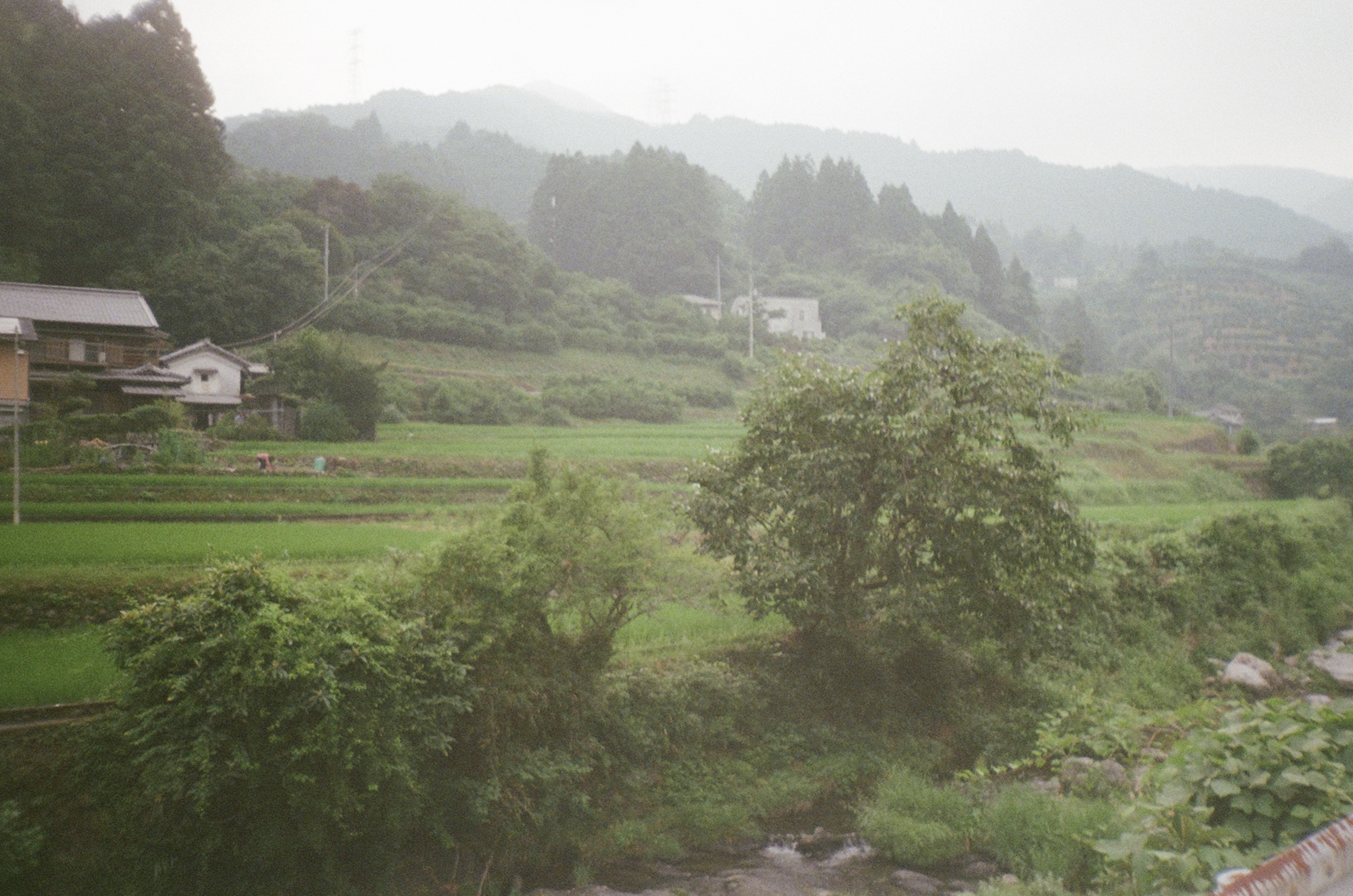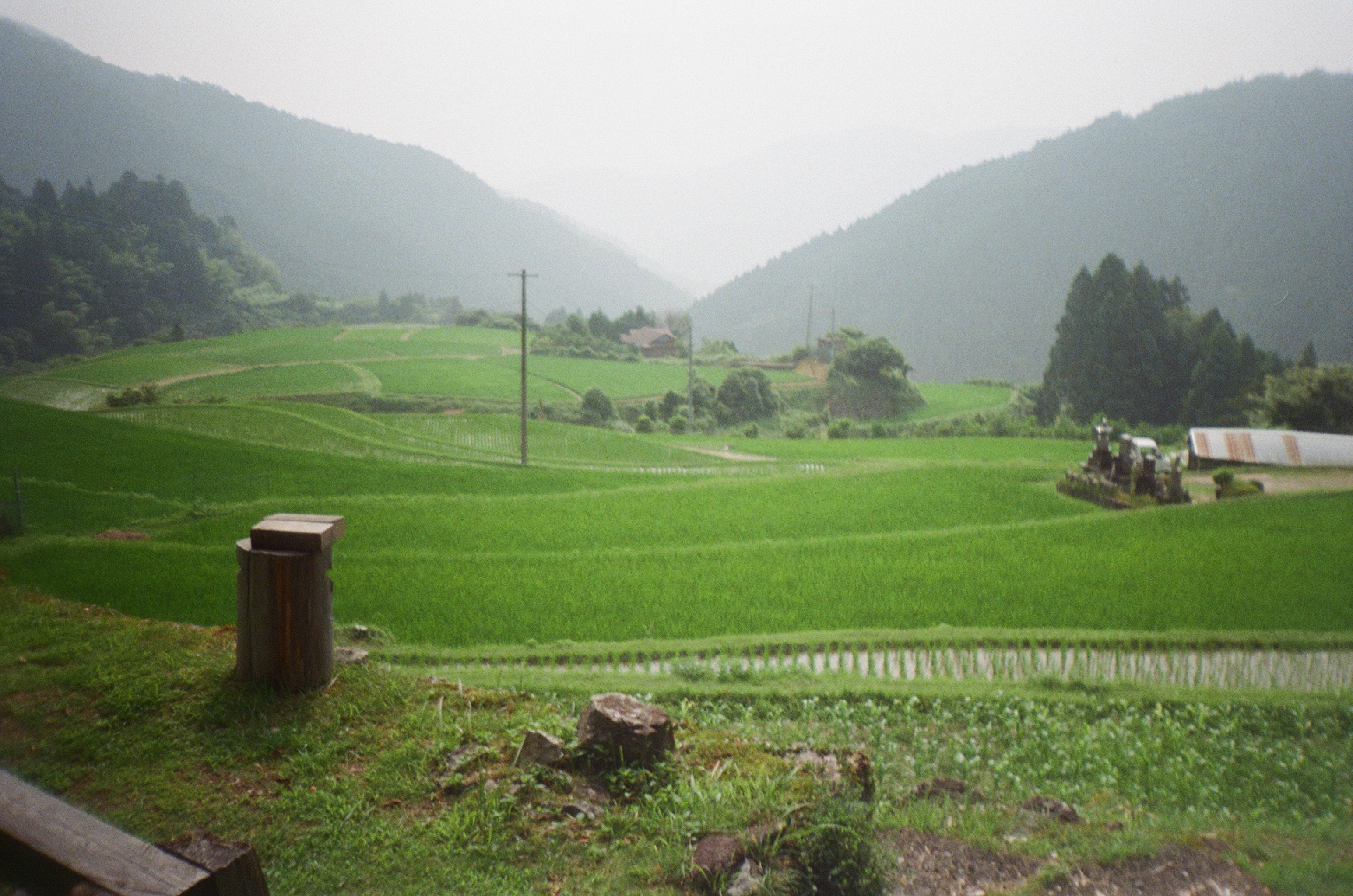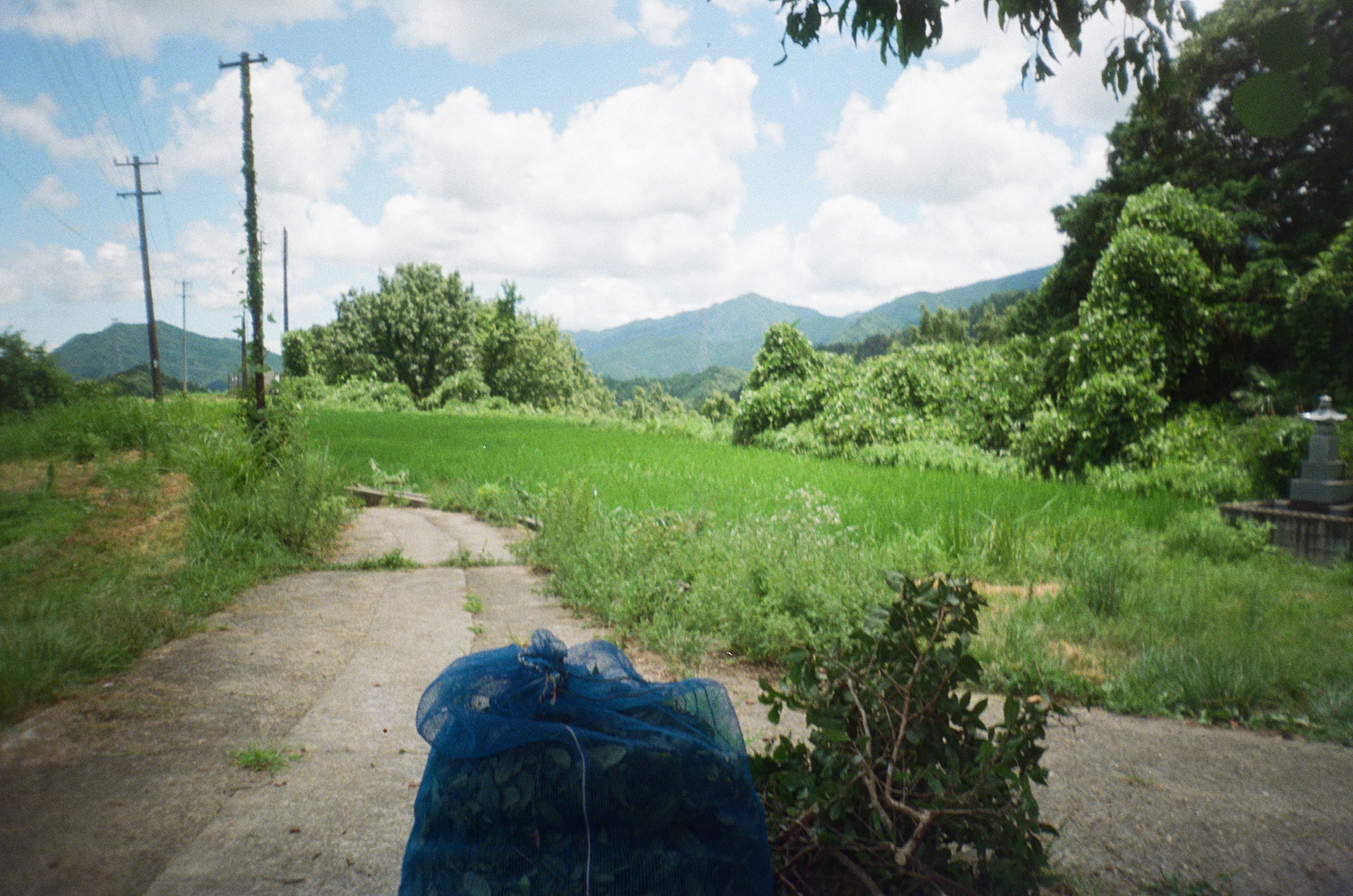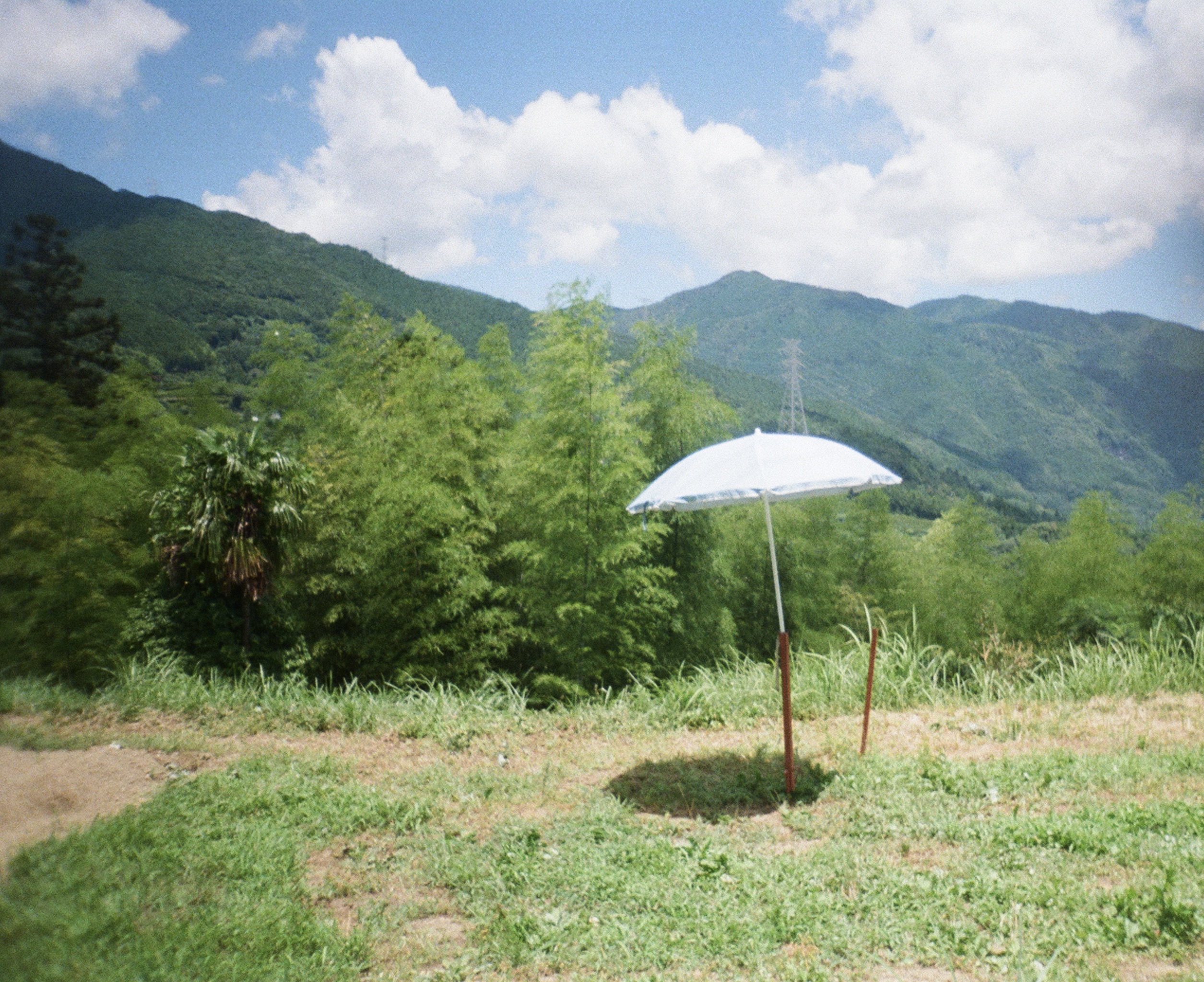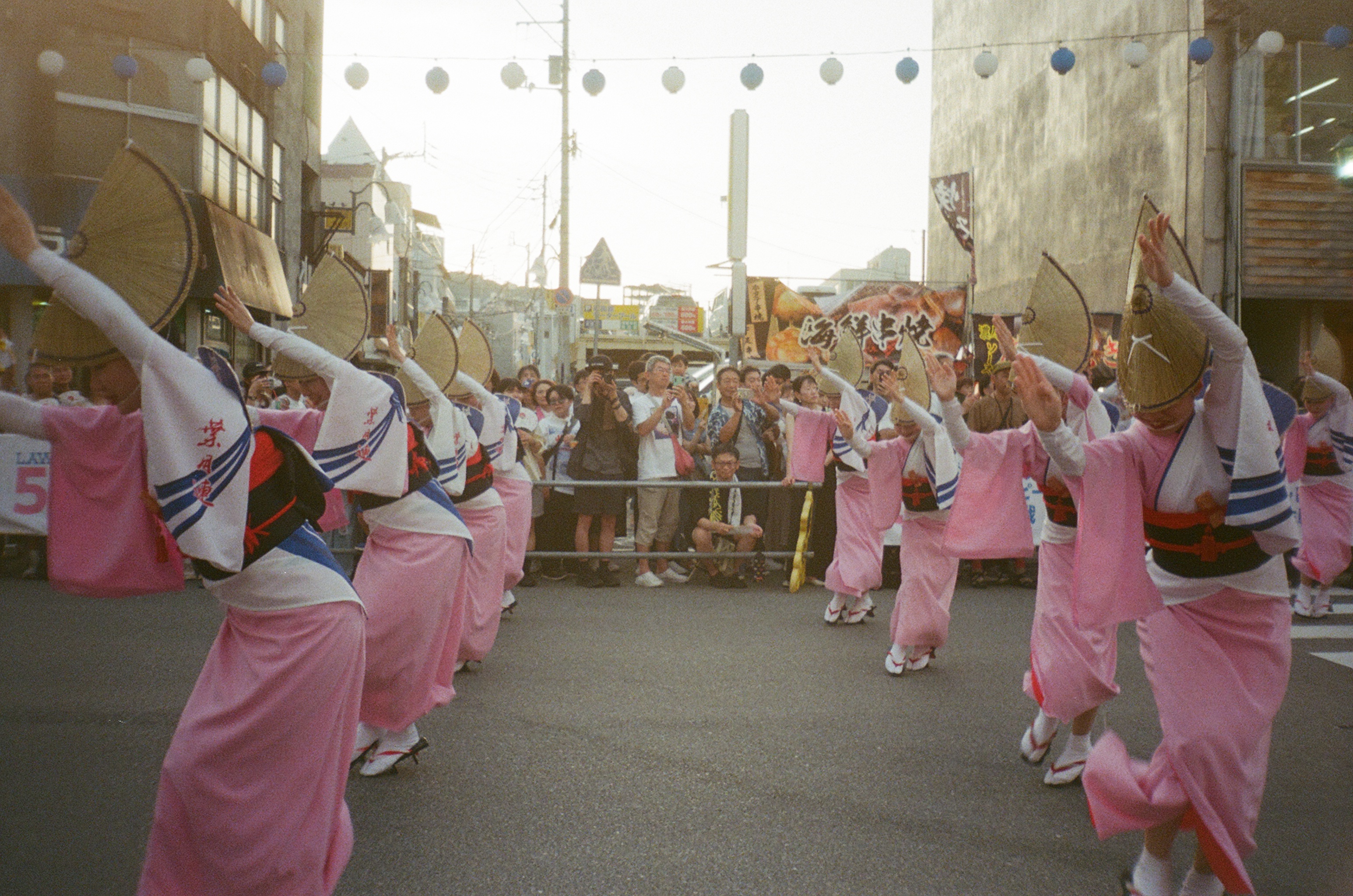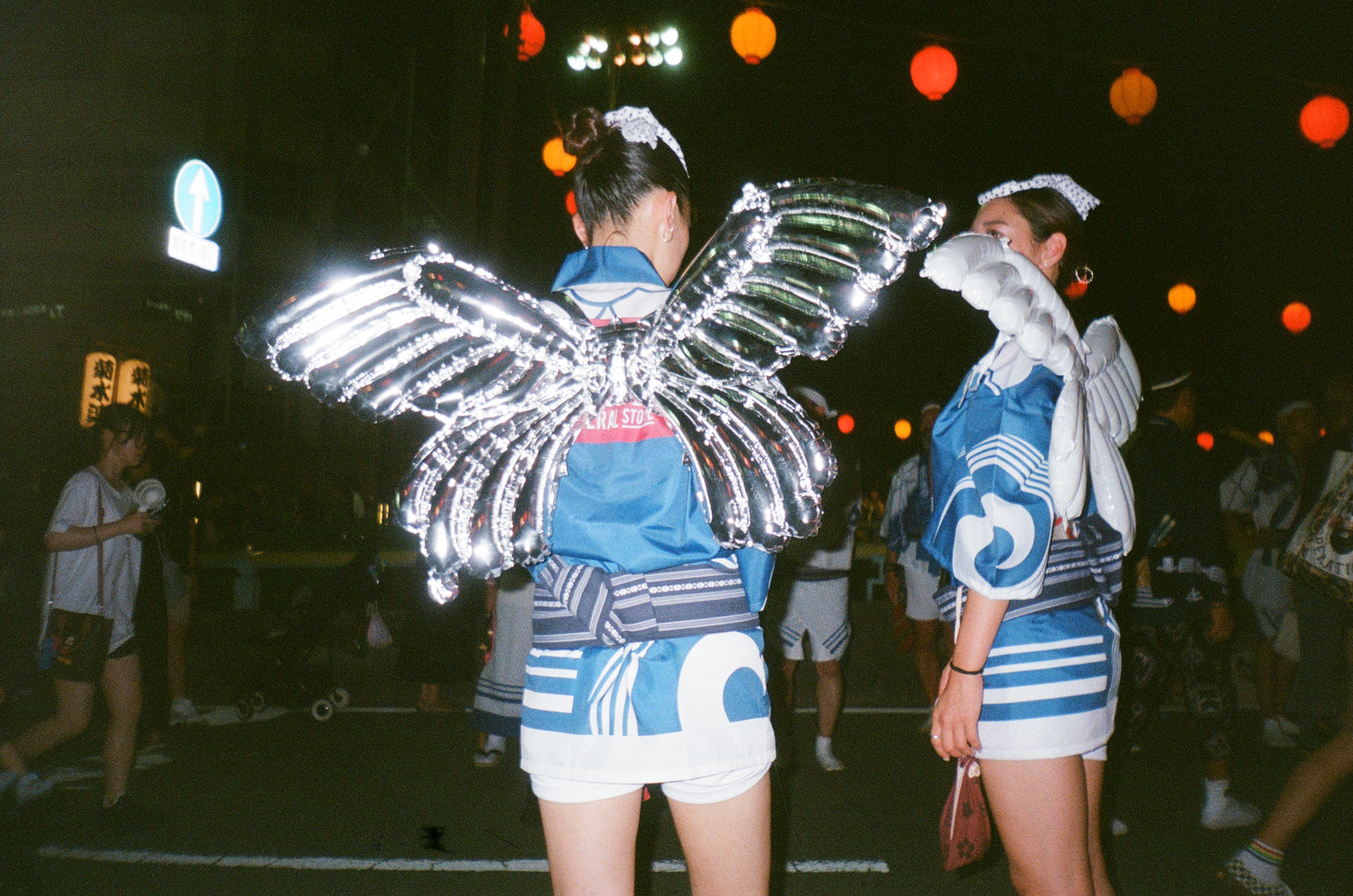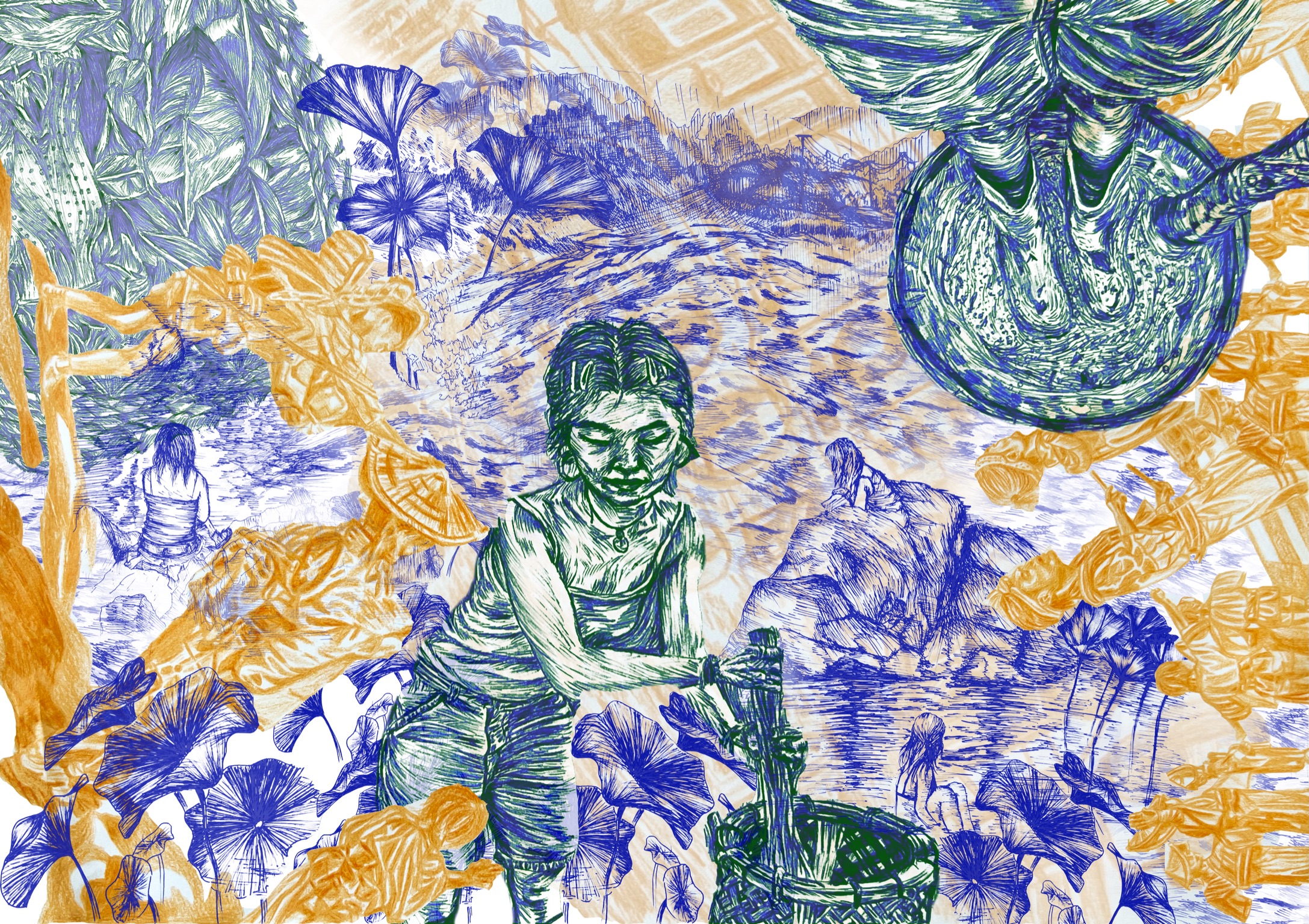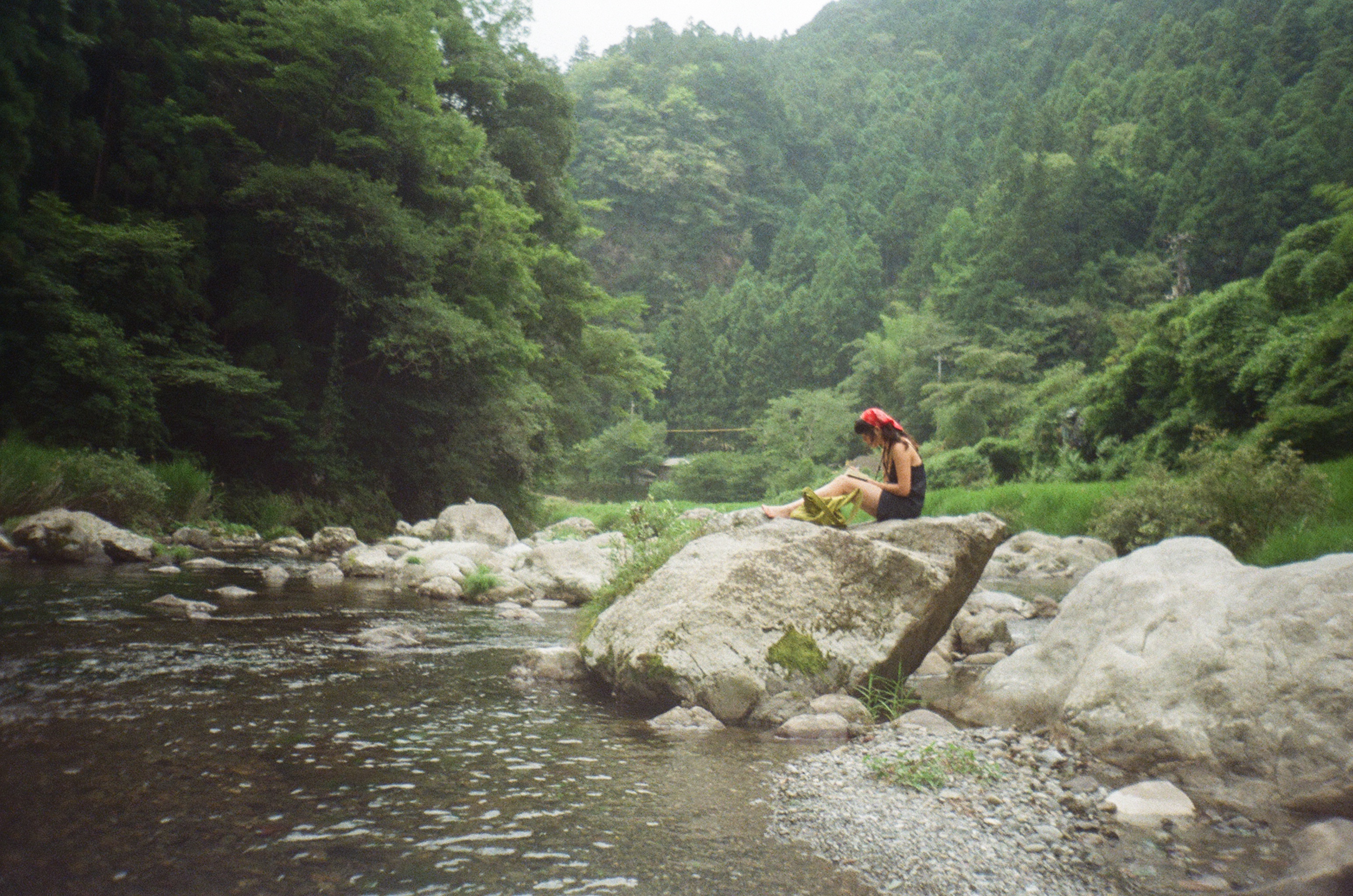

Hello! My name is Fifi Rae and I am thrilled to share my summer experience interning with INOW in Kamikatsu, Tokushima where I learned about zero-waste and how art can be a tool in communicating a different perspective to Kamikatsu's zero-waste system and lifestyle, countryside landscape and practices, innovative problem-solving, and tight-knit community. I created a visual presentation that follows the text below: INOW Summer Internship in Kamikatsu.
First, allow me to introduce myself. I was born in Nanjing, China, grew up in Los Angeles, CA, graduated from UC Berkeley in Art Practice and Art History, and recently moved to San Francisco. I am a lover of blue, a believer in ghosts, and a collector of names, wonders, and gossip. As a multidisciplinary artist, my primary medium is drawing but I am always incorporating large-scale installations, photography, projection, artist's books, and printmaking into my practice. I was introduced to Kamikatsu and INOW through my friend and eventual project partner, Katarina Ceguerra, who studied Landscape Architecture and Sustainable Environmental Design at UC Berkeley. Katarina's family friend did an internship with INOW a few years ago and took her to visit Kamikatsu where she met the program directors and other community members. During the spring, Katarina and I had the idea to collaborate and propose a project to INOW. We proposed an art project that would respond to our experiences with Kamikatsu, its waste system and community. We wanted to share our interests in climate justice, sustainability, art, design, and community.
For context, Kamikatsu is a very small town deep in the countryside of the Tokushima prefecture on Shikoku Island. Kamikatsu used to dispose of waste through incineration and open burning. In 1999, open burning was banned and there was an incineration cap, but incineration and landfills were still happening. Then, in the early 2000s, a recycling system became established by the government as a financial and environmental solution, 45 ways to sort and recycle your trash. In 2003, Kamikatsu became the first town in Japan to be declared zero-waste, which specifically meant to them "diverting 100% of waste from incineration and landfill to recycling." The INOW Program, founded in 2020 by Terumi Azuma, Linda Ding, and Kana Watando, and later joined by Sil Van de Velde, teaches visitors about Kamikatsu's everyday life and zero-waste practices through the sharing of knowledge, lived experiences, interactions, and exchanges between locals and travelers. INOW is an educational program that creates a unique experience and space for people all over the world to connect with Kamikatsu and reflect on sustainability and eco-conscious living. From local traditions passed on through generations to new innovative solutions for the future, INOW aims to inspire individuals with diverse backgrounds who are passionate about environmental issues and want to take action, through immersive, hands-on, community-centered programs and opportunities.
During our two months in Kamikatsu, our experiences were primarily building connections with local residents and other visitors from around the world, getting involved in community activities and events, and learning about different aspects of Kamikatsu. We worked at the zero-waste cafe, Cafe Polestar, with Terumi. This cafe uses local and seasonal ingredients and is a space for various social events. It was also a place for us to work on our project. We spent time at WHY, the zero-waste center, where everyone brings and sorts their trash. We learned how extensive the recycling can be but also how much easier the people here make it for the residents. We clean our trash beforehand, then WHY volunteers and staff help us sort all of it into the 45 different groups by materials. Additionally, we assisted INOW programming with the University of Singapore LASALLE College of the Arts Honors Design for Social Futures. This was an inspiring and impressive group to learn from as they were presenting projects they have been working on for social and community design with ideas and concepts they learned in Kamikatsu.
Kamikatsu is known for their Awa Bancha tea that is locally and internationally enjoyed. The summer is the season for tea picking and people come to help from around the world. The fermenting process was time-consuming and fascinating to watch and participate in. This is a sustainable, ritualistic, and educational practice that moves on an ecological timeline of the seasons. Another local practice that we learned was the Awa Odori dance for the annual Awa Odori Festival. Tokushima City draws in millions of people to watch this parade of dancers and dance on the streets together. Every week we practiced with the local residents of all ages and learned the Awa Odori dance to be performed at the Kamikatsu festivals. We also went to the city to watch a different teams from all over Japan perform, including the Kamikatsu team. Additionally, we spent time at the Kayabuki, or farm school, and rice fields. This place teaches people traditional farming practices and resourcefulness by using and reusing natural materials in their entirety. These practices need to be taught, learned, and shared with future generations, but it has been a struggle for these farmers and teachers to find young people who are interested.
There were a variety community events to attend as well like volleyball games between different neighborhoods, open mics at Ikumi cafe, and shared house dinners, where the interns visiting stayed at. The language barrier was a big concern, since neither of us spoke Japanese, but Kana and Terumi were key translators for everyone in the community, essential for the program to function and connect the world. Despite the language barrier, we were still able to develop meaningful connections with people through sharing experiences and practicing patience in trying to communicate with each other. We saw art as a universal language and tool we could use to bridge these barriers.
In Kamikatsu, zero-waste means to "prevent, reduce, reuse, and recycle waste." Throughout our time here, we got to hear and learn from different business owners, farmers, designers, and members of the community who are each contributing to the zero-waste system in their own way. They each asked the question, "what does zero-waste mean to me?" and the response ranged, expanding and deepening this term and idea. Terumi, co-founder of INOW, owner of Cafe Polestar, and a mother, gave a presentation early on that shaped our outlook and approach to the rest of our stay. She said that zero-waste connected her with the rest of the world. She meets people from all over the world because of their shared interest in sustainability and environmentalism; it brings people together. Zero-waste becomes a shared goal and a source of pride. It is important to recognize that zero-waste can be personal, communal, environmental, economical, educational, and more.
Changing people's minds and initial thoughts about waste can be challenging but offers a lot of creative potential. Designers and innovators ask how they can turn waste into something beautiful to change perspectives. Rise & Win is a great example of using design to appeal to their audience. This Kamikatsu brewery and barbecue restaurant salvages food waste and ferments them into beer and sake. Design throughout the town makes waste not only attractive but special, unforgettable, and fun. Zero-waste through design can bring back life and purpose into something thought to be "useless." Design can be a tool for bringing awareness to and addressing local problems, building a narrative and reframing culture, and changing behaviors through lived experiences
Sustainable practices, primarily seen at WHY, involve creative forms of reuse, recycle, and repurpose. The zero-waste center is one place that everyone in Kamikatsu goes to, a community space. This zero-waste system circulates people and ideas from the countryside to the city and vice versa. Each part contributes to a greater whole. Individuals must contribute to and participate in this system for it to work and benefit everyone, even though there is still a range of enthusiasm for zero-waste here. The mural of window panes at WHY and Rise & Win were created from the help of residents bringing their old windows. Nothing goes to waste because there is potential to constantly find use, purpose, and meaning in mundane objects, like old glasses and bottles becoming colorful chandeliers. Since different parts create a greater whole, recycling objects requires deconstructing the whole to account for and sort every part. To me, zero-waste came to mean a cyclical way of thinking, mutual accountability, care, and potential for creativity and community
Throughout our two months in Kamikatsu, we noticed that cycles were prevalent in the ecological, sustainable, and local practices that bring this community together. Our drawings and final poster are reflections of the different cycles we observed, the experiences we had, and the conversations we shared.
Ecological cycles are the basis for humans to live and adapt. We interviewed a farmer from the Kayabuki at the Yaeji Rice Fields and she gave us valuable insights into the cycles of water, rice crops, waste, and seasons. The water cycle in Kamikatsu, depicted in the first drawing by Katarina Ceguerra, is integral to the way of life and the work that people do. There are over 50 neighborhoods in Kamikatsu that each rely on the water that begins at the tallest mountain in Kamikatsu and separates into rivers and streams. The streams disperse through irrigation systems to the rice fields, farms, and houses. The houses have a pipe system that filters the water they use and returns the used water to the river. These streams are shared by the neighborhoods and must be co-managed to maintain. The rice fields mirror the shape of the natural landscape like the water follows the natural flow of the mountain streams. Water and landscape live in harmony, and people learn to live in harmony with these interconnected cycles. She said this is a town made by nature where humans do not decide the cycles but rather adjust themselves to them. For instance, people had to develop these water irrigation systems to bring water to certain areas for farming, adapting to the natural water cycle. The rice crops are used in their entirety to make brooms, rope, food, and roof structures. Then, these materials can be replaced and composted, allowing for more food and crops to grow. She said that by knowing where her water comes from and goes to, she feels a closeness to water that she did not feel when living in a city. Lastly, when she first came here, she received help and support from the community that enabled her to be part of it and eventually returned and shared that support to others.
As mentioned in the interview with the Yaeji rice farmer from before, people respond and adjust to the seasons and cycles that already exist. Two local practices that co-exist with this summer season are the Awa Odori festival and the Awa Bancha tea picking and processing, depicted in the last two drawings I created. The Awa Odori dance that we learned involved the repetition of oscillating between your left and your right, and often dancing in a circle. Kamikatsu residents dance in local festivals here and in the larger Tokushima events, while some people from Tokushima go to Kamikatsu to escape the crowds. Both practices bring people from all over the world out of curiosity to witness and to learn. The act of teaching and learning these practices is a cycle in itself, spreading knowledge and sharing experiences that cross borders and barriers. Both can be taught by doing and do not rely too heavily on spoken language, but rather a bodily and physical language. In connection to the farmer’s remark on the water cycle as a shared resource that can strengthen communities, each person plays a role in the community and can receive and give help to others. It is an exchange and cycle of learning and teaching. Both practices could not be done alone, for they are intended to be shared and experienced with others. The Awa Odori drawing can be viewed from any angle and rotates as people move between the city and the countryside. The Awa Bancha drawing depicts humans and nature interacting, where humans respond to natural cycles. The act of tea picking and processing is a repetitive motion from pulling the leaves off the branch, to stirring the leaves in boiling water, to stepping on them in a circle. Awa Bancha is interconnected with the cycle of water, food, waste, seasons, but cyclicality in the physical movement of picking and processing and the exchange in teaching and learning from countryside to city are similar to Awa Odori.
Overall, we noticed that these cycles are interconnected like humans and their environment. There is the natural/ecological cycle, the human/cultural cycle, and where the two intersect. Additionally, while viewing Kamikatsu through the lens of cycles, our poster is influenced by the pre-existing poster about zero-waste here split into lifestyle, education, and community. Our decision to make our poster free of language was to acknowledge the challenges in language barriers we experienced and the power of translation to bring people together. We hope this poster can act as a universal language to communicate our perspective of Kamikatsu cycles in conversation with the established systems, ideas, practices, and forms of communication here.
Our experiences in Kamikatsu left us with many takeaways and questions we will carry with us in the future, shifting our perspectives on building accessible communities in other places. Through the physical isolation of the countryside, we were able to turn to and form meaningful connections with the community near us, intergenerationally and internationally. Isolation in nature also allowed us to become more aware of the cycles around us. Accessibility is a topic that stood out to us and has left us with questions on how to bring more accessibility to community spaces, especially in places that are inherently inaccessible due to their landscape. While large cities can sometimes feel scarce of accessible community spaces, they have systems in place that accommodate people with physical disabilities that small towns in the countryside might lack. Both the countryside and the city can learn from each other to create resolutions for the issue of accessibility. Lastly, a reflection we had was about accountability, trust, and the desire to help each other. As mentioned before, there is no anonymity in Kamikatsu due to its size which keeps everyone accountable to do their part for the whole community. There is a sense of mutual trust and responsibility, from participating in the zero-waste system at WHY to teaching each other skills and practices. Something unique to Kamikatsu that allowed us to access more places and experiences was the shared ride system. So many people, often meeting for the first time, are willing to give each other rides with nothing in return. Overall, we imagine this project and the ideas, reflections, and questions we have formed these past two months in Kamikatsu will continue to grow, develop, and transform in a cycle of its own. I hope from sharing this experience, there will be a greater, global circulation of ideas and conversations on how to incorporate Kamikatsu's sustainable methods, innovative solutions, and community values to other places around the world.
I want to acknowledge and thank INOW, specifically Kana, Sil, and Terumi, and everyone I met in Kamikatsu for this experience. Please check out the INOW website for more information on them. Lastly, you can reach me with any questions and thoughts at fifi@mickimeng.com and visit my website.
